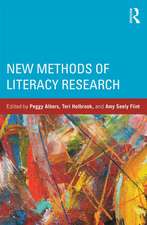Telling Pieces: Art As Literacy in Middle School Classes
Autor Peggy Albers, Sharon Murphyen Limba Engleză Paperback – dec 1999
Beginning with an overview of social semiotics and emergent literacy theorizing, the authors set the stage for their study of sixth graders involved in art. A galleria of children's artworks is presented, allowing readers/viewers to consider these texts independent of the authors' interpretations of them. Then, set against the galleria is the story of the community and school contexts in which the artworks are produced--contexts in which racism, homophobia, and the repression of creativity are often the norm. The interpretation the authors bring to bear on the artworks reveals stories that the artworks may or may not tell on their own. But the tales of artistic literacy achievement are counterbalanced by reflection about the content of the artworks produced, because the artworks reveal the impossibility for students to imagine beyond the situational bounds of racism, homophobia, and religiosity. The authors conclude by raising questions about the kinds of conditions that make literacy in art possible. In doing so, they explore selected alternative models and, in addition, ask readers to consider the implications of the ideological issues underlying teaching children how to represent their ideas. They also advocate for a participatory pedagogy of possibility founded on ethical relational principles in the creation and interpretation of visual text.
Of particular interest to school professionals, researchers, and graduate students in literacy or art education, this pioneering book:
* brings together the fields of art education and literacy education through its focus on how middle school students come to work with and understand the semiotic systems,
* introduces sociolinguistic, sociological, and postmodernist perspectives to thinking about children's work with art--adding a new dimension to the psychological and developmental descriptions that have tended to dominate thinking in the field,
* includes a galleria of 40 examples of children's artwork, providing a unique opportunity for readers/viewers to interpret and consider the artwork of the sixth graders independent of the authors' interpretations,
* presents descriptions of art teaching in process,
* gives considerable attention to the interpretation of the children's artworks and the influences that contribute to the content they represent, and
* considers varying models of art education along with the implications of introducing new representational possibilities.
Preț: 232.82 lei
Nou
Puncte Express: 349
Preț estimativ în valută:
44.55€ • 46.64$ • 36.86£
44.55€ • 46.64$ • 36.86£
Carte tipărită la comandă
Livrare economică 05-19 aprilie
Preluare comenzi: 021 569.72.76
Specificații
ISBN-13: 9780805834635
ISBN-10: 080583463X
Pagini: 176
Dimensiuni: 152 x 229 x 13 mm
Greutate: 0.33 kg
Ediția:1
Editura: Taylor & Francis
Colecția Routledge
Locul publicării:Oxford, United Kingdom
ISBN-10: 080583463X
Pagini: 176
Dimensiuni: 152 x 229 x 13 mm
Greutate: 0.33 kg
Ediția:1
Editura: Taylor & Francis
Colecția Routledge
Locul publicării:Oxford, United Kingdom
Public țintă
ProfessionalRecenzii
"Telling Pieces is a clearly written and interesting book. It has much of value to say to students, teachers and teacher educators about teaching and learning. And what it says about art education as a collaborative process guided by teachers who are also expert and practising artists, needs to be heard."
—The British Journal of Educational Psychology
"Brings the critical perspective developed in the language education field into juxtaposition with current thinking about art education....The authors cut across discipline boundaries to carve out a semiotic perspective. In essence, they extend their literacy perspective to include the sign system of visual art....This book takes important steps toward reframing the theory underlying curriculum and exposing the ways culture and schooling influence what students are able to think and say. It opens a window on multiple ways of knowing and adolescent development that permits us to view some disturbing images, but the authors go on to contextualize what we see, to sort out the implications, and to explain the transforming potential of art."
—Beth Berghoff
Indiana University at Purdue
"Rich in current theory and grounded in the realities of the classroom and community at the same time....Semiotics is a field that has received short shrift in literacy education....This text fills this gaping hole in a way that other books on art literacy do not."
—Ruth Shagoury Hubbard
Lewis & Clark College
—The British Journal of Educational Psychology
"Brings the critical perspective developed in the language education field into juxtaposition with current thinking about art education....The authors cut across discipline boundaries to carve out a semiotic perspective. In essence, they extend their literacy perspective to include the sign system of visual art....This book takes important steps toward reframing the theory underlying curriculum and exposing the ways culture and schooling influence what students are able to think and say. It opens a window on multiple ways of knowing and adolescent development that permits us to view some disturbing images, but the authors go on to contextualize what we see, to sort out the implications, and to explain the transforming potential of art."
—Beth Berghoff
Indiana University at Purdue
"Rich in current theory and grounded in the realities of the classroom and community at the same time....Semiotics is a field that has received short shrift in literacy education....This text fills this gaping hole in a way that other books on art literacy do not."
—Ruth Shagoury Hubbard
Lewis & Clark College
Cuprins
Contents: Preface. Introduction. The Representation of Meaning. Galleria. Location, Loss, and Longing. Freedom, Form, and Feedback. Identity, Ideology, and Image. Creating Conditions for Art as Literacy. Appendix: Methodology Notes.
Descriere
Uses the case of a 6th grade classrm in a small US town to systematically consider how pre-adolescent middle-school children develop a knowledge & understanding of the conventions of art & how they use this knowledge to create artful representations.












